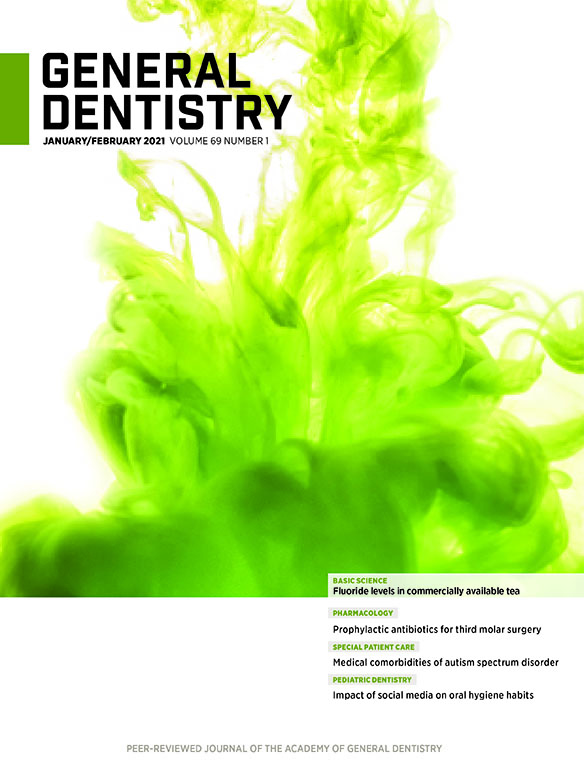-
SELF-INSTRUCTION
Basic Science
Evaluation of fluoride levels in commercially available tea in the United States
Spencer Regelson
Mojdeh Dehghan
Daranee Tantbirojn
Hassan Almoazen
This study compared fluoride levels in commercially available black, green, and matcha teas. All teas had some fluoride content, but the values differed significantly among all of the brands and types. Drinking tea could aid caries prevention but may increase the risk of fluorosis if consumed to excess.
2021 January/February; 69(1):17-20.
Full Article (PDF)
Self-Instruction Exercise No. GD468
-
Oral Medicine, Oral Diagnosis, Oral Pathology
An unusual case of oral phleboliths without evidence of associated vascular anomalies
Natália Galvão Garcia
Viviane Maciel de Almeida Lage
Hugo Bonette de Carvalho
Alessandro Antônio Costa Pereira
João Adolfo Costa Hanemann
This case report describes the discovery of noncalcified phleboliths that were not associated with any vascular anomalies, which is an unusual presentation. The finding of negligible calcium in the recently developed lesions suggests that the calcification process of phleboliths is relatively slow.
2021 January/February; 69(1):22-25.
Full Article (PDF)
-
SELF-INSTRUCTION
Pediatric Dentistry
Enhancing the pediatric dentistry skills and knowledge of general dentists
Patrick S. Lolo
Oscar Arevalo
Daniel M. Saman
When the outcomes of a pediatric dentistry training initiative for general dentists were evaluated, participants reported an increase in the number of children treated and the scope of services they provided. Training initiatives seeking to enhance the clinical skills and knowledge of general dentists may be an effective tool for increasing access to care for children.
2021 January/February; 69(1):26-29.
Full Article (PDF)
Self-Instruction Exercise No. GD469
-
Prosthodontics
Comparison of different methods for obtaining centric relation: a systematic review
Clóvis Lamartine de Moraes Melo Neto
Emily Vivianne Freitas da Silva
Isabela Caroline de Sousa Ervolino
Daniela Micheline dos Santos
André Pinheiro de Magalhães Bertoz
Marcelo Coelho Goiato
A systematic review of the literature was conducted to verify which technique generates the greatest reproducibility of the centric relation. Based on the guided methods and swallowing technique, it is not possible to conclude which technique can generate the greatest reproducibility of the centric relation. However, analysis suggests that in most cases intraoral gothic arch tracing is superior or equivalent to guided methods.
2021 January/February; 69(1):31-36.
Full Article (PDF)
-
Occlusion
Volumetric evaluation of temporomandibular joints in patients with a chewing-side preference: a CBCT study
Eliana Dantas Costa
Amanda Farias Gomes
Afonso Celso Souza de Assis
Glaucia Maria Bovi Ambrosano
Sérgio Lúcio Pereira de Castro Lopes
Evaluation of the cone beam computed tomograms of 90 patients revealed that chewing-side preference does not influence the volume of the mandibular condyle or coronoid process or the dynamic parameters of the temporomandibular joint.
2021 January/February; 69(1):38-43.
Full Article (PDF)
-
SELF-INSTRUCTION
Basic Science
Erosive potential of powdered juice drinks on dental enamel
Dayse Andrade Romão
Camila Pedrosa de Lima
Maelly Vicente Lôbo
Letícia Del Rio Silva
Diego Figueiredo Nóbrega
Natanael Barbosa dos Santos
The erosive potential of powdered juice drinks on dental enamel was evaluated in 2 stages: physicochemical characterization and erosive challenge testing. In stage 1, the pH and titratable acidity of powdered juices were analyzed. In stage 2, the erosive effect of 5 juices was tested using a pH cycling model and bovine dental enamel blocks. The results demonstrated that commercially available powdered juice drinks, especially lemon juice, present erosive potential and lead to surface loss of dental enamel.
2021 January/February; 69(1):44-49.
Full Article (PDF)
Self-Instruction Exercise No. GD470
-
Restorative Dentistry
Clinical decision-making regarding endodontic therapy vs extraction and implant-assisted replacement: a systematic review and meta-analysis
Mohammed Edrees Sayed
Carlos Alberto Jurado
Akimasa Tsujimoto
Jose Obed Garcia-Cortes
This systematic review examined the literature regarding the outcomes of endodontic treatment vs extraction and implant-assisted replacement. Meta-analyses revealed that both treatments had similar outcomes, with endodontic therapy proving slightly better when survival rates were considered as failure rates.
2021 January/February; 69(1):52-57.
Full Article (PDF)
-
Periodontics
Contemporary minimally invasive VISTA approach for gingival recession coverage: a case series
Rajendran Poornima
Anand Meena
In this case series, the vestibular incision subperiosteal tunnel access (VISTA) technique was used, without additional grafting, to treat Class I or II gingival recession at 28 sites in 10 patients. The posttreatment clinical attachment level, Gingival Index, width of attached gingiva, and height of gingival recession improved significantly compared to baseline. The mean percentage of root coverage achieved was 78.99%, and 19 sites showed 100.0% root coverage.
2021 January/February; 69(1):58-61.
Full Article (PDF)
-
Special Care Dentistry
Medical comorbidities associated with autism spectrum disorder and their impact on dental care
Evan Spivack
Individuals with autism spectrum disorder, a neurodevelopmental disorder affecting communication, behavior, and socialization, often present with multiple medical comorbidities that affect dental treatment. This article reviews the most common of these neurologic, psychiatric, and gastrointestinal issues and explores their relevance to dental care.
2021 January/February; 69(1):62-68.
Full Article (PDF)
-
Pediatric Dentistry
Impact of social media on the oral hygiene habits of children and adolescents: a randomized controlled clinical trial
Sabrina Natasha Digiacomo Sarwer-Foner
Jéssica Copetti Barasuol
Ricardo de Sousa Vieira
This study compared the impact of conventional and digital education approaches on the oral hygiene outcomes and habits of children and adolescents. Students were randomly allocated to the control group, which received conventional oral health education, or the experimental group, which received both conventional education and digital oral health content through WhatsApp Messenger. Both groups presented a 30% reduction in PI after the educational interventions, but the experimental group flossed significantly more frequently than the control group. The smartphone app seemed to be an effective auxiliary resource for providing oral health education.
2021 January/February; 69(1):70-76.
Full Article (PDF)

